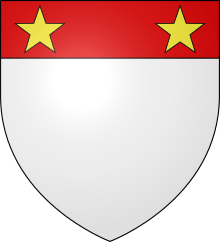George St John, 3rd Viscount Bolingbroke
George Richard St John, 3rd Viscount Bolingbroke and 4th Viscount St John (5 March 1761 – 11 December 1824[1]), styled The Honourable George St John from birth until 1787, was a British peer and politician. He became famous in his own lifetime for embarking on an extra-marital relationship with his own half-sister, Mary Beauclerk (his mother's daughter by her second marriage), that produced four sons. The two lovers had to leave England and live on the continent for a time.[2]
George St John, 3rd Viscount Bolingbroke | |
|---|---|
 Arms of St John: Argent, on a chief gules two mullets or | |
| Member of the Great Britain Parliament for Cricklade | |
| In office 1782–1784 | |
| Preceded by |
|
| Succeeded by | |
| Personal details | |
| Born | 5 March 1761 |
| Died | 11 December 1824 (aged 63) Pisa, Italy |
| Mother | Diana Spencer |
| Father | Frederick St John, 2nd Viscount Bolingbroke |
Background
He was the elder son of the famously unhappy marriage between Frederick St John, 2nd Viscount Bolingbroke and Diana Spencer, daughter of Charles Spencer, 3rd Duke of Marlborough.[3] St John was educated at Eton College in Berkshire and Christ Church, Oxford, where he matriculated in 1777.[4] He succeeded his father as viscount in 1787.[5]
Career
St John entered the British House of Commons for Cricklade in 1782, at the age of 21, representing the constituency as Member of Parliament (MP) until 1784.[6]
Family
On 26 February 1783, he married firstly Charlotte Collins, daughter of his former tutor Thomas Collins. He had by her two sons and a daughter.[7] After the birth of these three children, George embarked on a sexual relationship with his younger half-sister Mary Beauclerk. Mary was a twin from their mother's second marriage to Topham Beauclerk, but born in 1766 before their marriage 1768. George and Mary's child was delivered in Paris but passed off at home as a child of George and Charlotte's for a time. Charlotte was anxious to save her marriage, and hoped by this ruse to preserve the family name from infamy and her marriage from ruin. However, Mary became pregnant for the second time by George in 1788, and delivered their second child, again in France.
In 1789 George abandoned his wife and legitimate children. He and Mary along with their two small children left Britain to live together on the Continent. They traveled under the name 'Barton' and left instructions to their families not to try to find them. The story quickly reached their circle of family and influential friends, and was reported in The Times (7 July 1789). Mary went on to bear him another two sons, all of whom lived to adulthood. By May 1794 George had abandoned Mary and the four boys for a Belgian noblewoman, Isabella Charlotte Antoinette Sophia Hompesch, Baroness von Hompesch. He persuaded her to marry him bigamously and then to live with him in obscurity first on the Continent, then in Britain, and finally in the United States. Their eldest children were all illegitimate.
Mary later (1797) married an Anglo-German Bavarian count Franz Jenison von Walworth, by whom she had legitimate issue and descendants. At least one of her sons by St John, Robert St John, called Bob St John, was still alive and much loved by the politician Charles James Fox and his mistress, later wife Elizabeth Armistead.
Charlotte died in 1803, and St John lawfully married Isabella Hompesch on 1 August 1804.[7] By his second wife, he had legitimate issue, two daughters and two sons.[8] St John died, aged 63, at Pisa in Italy on a journey to regain his daughter's health.[8] He was succeeded in his titles by his oldest surviving son Henry St John, 4th Viscount Bolingbroke,[5] as the oldest son George had died in 1804 just before his mother.[9]
References
- "Leigh Rayment - Peerage". Retrieved 20 June 2009.
- Hicks, Carola. Improper Pursuits: The scandalous life of an earlier Lady Diana Spencer 2001. ISBN 0-312-29157-4
- Burke, John (1832). A Genealogical and Heraldic History of the Peerage and Baronetage of the British Empire. vol. I (4th ed.). London: Henry Colburn and Richard Bentley. p. 127.
- "ThePeerage - George Richard St. John, 3rd Viscount Bolingbroke". Retrieved 16 January 2007.
- Lodge, Edmund (1838). The Genealogy of the Existing British Peerage (6th ed.). London: Saunder and Otley. pp. 57.
- "Leigh Rayment - British House of Commons, Cricklade". Archived from the original on 24 September 2014. Retrieved 20 June 2009.
- Debrett, John (1816). Debrett's Peerage of the United Kingdom of Great Britain and Ireland. vol. I (10th ed.). London: G. Woodfall. p. 365.
- Sylvanus, Urban (1825). The Gentleman's Magazine. part I. London: John Harris. p. 179.
- Lundy, Darryl. "p. 3515 § 35146". The Peerage.
| Parliament of Great Britain | ||
|---|---|---|
| Preceded by Paul Benfield John Macpherson |
Member of Parliament for Cricklade 1782 – 1784 With: Paul Benfield |
Succeeded by Charles Westley Coxe Robert Adamson |
| Peerage of Great Britain | ||
| Preceded by Frederick St John, 2nd Viscount |
Viscount Bolingbroke and St John 1787 – 1824 |
Succeeded by Henry St John, 4th Viscount |